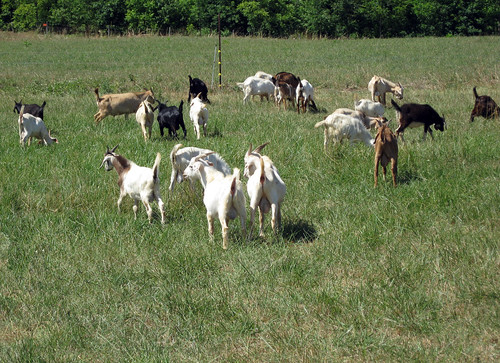Goats gain well
For the first 14 days of the test, the goats gained an average of 4.4 lbs (2.2 kg) or 0.315 lbs. (143 g) per day. Gain ranged from -5 to + 13 lbs. or -0.375 to 0.929 lbs. per day. Only three goats lost weight. Two goats neither gained nor lost weight. The three goats that lost weight either have or had poor FAMACHA© scores. David Gordon determined weights.
 |
| David Gordon weighs a goat. |
FAMACHA©, body condition, coat condition and dag scores were determined by Susan Schoenian. Individiual and pooled fecal samples were collected from the goats. So far, the only fecal data that has been received indicated a pooled fecal egg count of 1,100 eggs per gram on June 5.
13 goats dewormed
FAMACHA© scores (1-5) ranged from 1 to 5 and averaged 1.8, compared to 1.6 two weeks ago. While only two goats had FAMACHA© scores of 4 or 5, thirteen goats were dewormed.
Due to early unexpected parasite problems among some goats, the decision was made to deworm goats with FAMACHA© scores of 3 or greater. It was also decided that levamisole drench would be used for deworming (instead of moxidectin).
Levamisole
The general recommendation (by small ruminant parasitologists) is that goats receive 1.5 times the labeled sheep dose of levamisole. This cautious recommendation is due to the narrower margin of safety for the drug. Off the market for approximately two years, levamisole (Prohibit® sheep drench) is now available in limited supply.
 |
| Cool season grass pasture |
Body condition scores (1-5) ranged from 1.5 to 3.5 and averaged 2.6. A few of the parasitized goats lost significant body condition. Coat condition scores (1-3) ranged from 1.5 to 3. Lower scores are usually due to lice or dandruff. Dag scores (1-5) ranged from 1 to 5 and averaged 1.5. Dag scores of 4 or 5 are usually indicative of active scouring (diarrhea).
Dry conditions
Pasture conditions at the test site are rapidly deteriorating due to the dry weather. After a reasonably wet spring, the test site receive very little rainfall in June. Cool season grasses turn brown and cease growing very quickly in a drought. On the other hand, if there is enough variety (and pasture), goats, as selective grazers, tend to fare well in a drought. They currently have access to several paddocks.
 |
| Growing pearl millet |
A two-acre field of dwarf pearl millet (pictured above), a summer annual grass, is not yet available for grazing, but could prove to be very important for this year's test. If the dry weather conditions persist, supplemental nutrition may be necessary (e.g. nutritional tubs and/or hay). Pray for rain!











